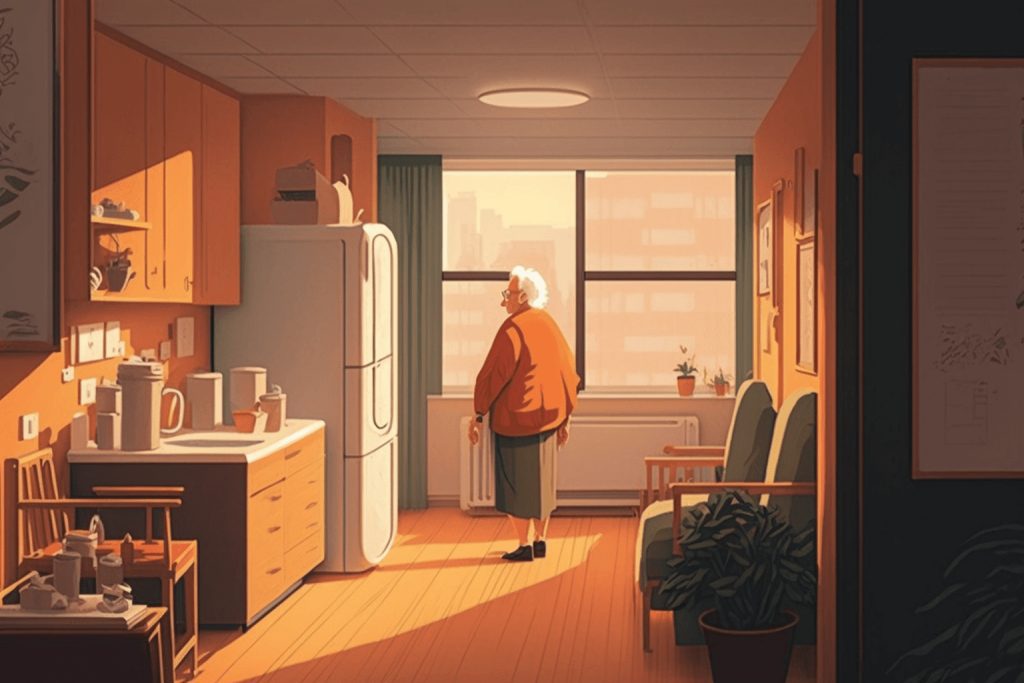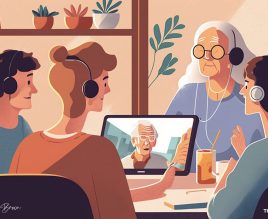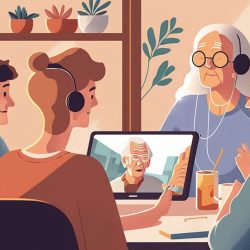Table of Contents
ToggleAs we age, the longing to retain our independence and continue living comfortably in our own homes intensifies. However, physical and mental health concerns can pose challenges. What if the solution lies in smart living, particularly for seniors? Imagine a world with smart homes for seniors along with wearable technology and the Internet of Things (IoT) to age in place. This isn’t a sci-fi prediction; it’s happening now.
Smart living offers a multitude of benefits to older adults. It’s not merely about convenience; it’s about fostering a safer, more independent lifestyle. The seamless integration of smart homes, wearable tech, and IoT devices presents a promising solution for ageing in place. From monitoring health parameters to ensuring security, technology for independent living is gradually becoming a reality.
Let’s venture into this intriguing intersection of age, technology, and independence, shedding light on how the merging of different subjects, i.e., gerontology and technology, open doors for novel solutions. Stay with us as we embark on this journey, redefining the concept of ‘aging in place’. With recent innovations as our compass, we will chart the course for senior-friendly smart living.
Smart Homes for Seniors
Now that we’ve delved into the broader concept of smart living, let’s narrow our focus to smart homes and how they significantly benefit older adults. Smart homes, by definition, are residences equipped with technology that automates tasks, making everyday life more manageable.

For seniors, these advancements aren’t merely about ease or convenience; they are potentially life-changing, enabling safer and more independent living. Let’s delve into what a smart home is, its benefits for seniors, the devices that make it senior-friendly, and how to implement these solutions for aging in place.
What is a Smart Home and How It Benefits Seniors
A smart home integrates technology into a seamlessly connected system, automating various aspects of a house’s operations. From lighting to temperature control to security, smart homes offer simplified, remote control of household functions.
For seniors, smart homes aren’t just about managing their homes more efficiently; they also serve a more profound purpose—enhancing safety and independence. Automatic lighting systems can help prevent accidents by ensuring the home is adequately lit at all times.
Smart thermostats can regulate temperature for seniors who might be sensitive to sudden changes. With video doorbells and security systems, seniors can feel safer in their homes, knowing they can monitor their surroundings remotely.
Senior-Friendly Smart Home Devices and Solutions
Several smart home devices can make a home more senior-friendly. Voice-controlled assistants like Alexa or Google Home can perform tasks like setting reminders for medication or turning off appliances, minimizing potential hazards. Smart security systems, including video doorbells and window sensors, offer peace of mind.
For seniors with mobility issues, smart locks and garage doors can be operated remotely.
Automated lighting systems can reduce the risk of trips and falls by illuminating paths at night or in low-light conditions. Similarly, smart thermostats ensure a consistent, comfortable temperature, vital for seniors’ well-being. Finally, health monitoring devices, such as smart scales or sleep trackers, can help seniors and their caregivers monitor their well-being and act on any health irregularities quickly.
Implementing Smart Home Solutions for Aging in Place
Adopting smart home solutions for aging in place involves careful consideration. Firstly, understand the needs of the senior individual—what aspects of their daily life could be simplified or made safer through technology? Once you’ve identified these areas, research the available devices. Not all solutions will be suitable for every individual; choose devices that are user-friendly and meet specific needs.

Remember, the goal is to enhance independence and safety, not to complicate life with technology. Start with one or two devices—may be a voice assistant and a smart lighting system—and gradually incorporate more as the individual becomes comfortable.
Finally, ensure there’s a support system in place for troubleshooting tech issues. Whether it’s a tech-savvy grandchild or a professional service, having reliable tech support is crucial when implementing smart home solutions for aging in place.
Wearable Technology for Older Adults
Let’s transition from smart homes to wearable technology—a revolutionary concept that has gained significant traction among older adults. The advent of wearable technology is changing the face of senior living. In the past decade, the market for wearable tech has exploded, offering devices that track health metrics, provide safety alerts, and even facilitate communication.
For seniors, these devices have become a conduit to a safer, more independent lifestyle. Health-tracking wearables monitor vital signs and physical activity, providing valuable data that can inform healthcare decisions. GPS-enabled devices offer peace of mind to both seniors and their loved ones, providing real-time location tracking in case of emergencies.
Moreover, communication-enabled wearables keep seniors connected with their families, reducing feelings of isolation. The rise of wearable tech has brought seniors to the forefront of this technological revolution, giving them tools to maintain independence and health while aging in place. Popular
Wearable Devices for Seniors: Health, Safety, and Connectivity
A variety of wearable devices cater to seniors’ specific needs. For health monitoring, smartwatches like the Apple Watch or Fitbit devices track heart rate, sleep patterns, and daily activity levels. Some models even detect falls, a crucial feature for older adults. GPS-enabled wearables provide location tracking—a useful tool for family members or caregivers who want to ensure the safety of their loved ones.
Devices like the GreatCall Lively Mobile Plus even include emergency response services. For seniors seeking to stay connected, smartwatches offer the ability to send and receive calls or messages and even connect to voice assistants for hands-free operation.
How Wearables Empower Seniors to Live Independently and Safely
Wearable devices do more than just provide data or functionality—they empower seniors to live independently and safely. By continuously monitoring health metrics, wearables can help older adults maintain a healthy lifestyle, identify potential health concerns early, and prevent serious complications. GPS-enabled wearables give seniors the freedom to move around while offering peace of mind to their loved ones.
Knowing help is just a button press away in case of emergencies boosts seniors’ confidence to live independently. Finally, wearables foster connection—keeping seniors in touch with their loved ones, reminding them of medication times, and even providing entertainment. In conclusion, wearable technology has a significant role in promoting independent living among seniors, adding an essential layer of safety and health monitoring.
The Internet of Things (IoT) and Aging in Place
Lastly, we can’t discuss smart living for seniors without acknowledging the critical role of the Internet of Things (IoT). IoT refers to the network of physical devices connected to the internet, sharing and receiving data. For seniors, IoT presents exciting possibilities, paving the way for more independent and safe living.
From health monitoring to smart home management, IoT devices are transforming senior living. In this section, we’ll explore the concept of IoT, highlight devices tailored for seniors, and provide guidance on integrating these solutions into a senior-friendly living environment.
Understanding IoT and Its Potential for Senior Living
The Internet of Things (IoT) is a vast network where everyday objects—refrigerators, thermostats, or watches—connect to the internet and to each other, facilitating data exchange. This interconnectedness allows for automation, remote control, and data collection, resulting in enhanced functionality and convenience.
In the context of senior living, IoT holds immense potential. It can transform everyday devices into tools that monitor health, enhance safety, and streamline everyday tasks, supporting independent living for seniors. For example, IoT-enabled health devices can monitor vitals, alerting caregivers of any abnormalities. IoT-connected smart homes can automate lighting, temperature control, and security, creating a safer living environment.
IoT Devices Designed to Support Seniors’ Independence
Several IoT devices are tailored to promote seniors’ independence. IoT health devices, such as remote patient monitoring systems, can track vitals and other health data, sending alerts when values are out of normal ranges.
Smart pill dispensers can keep track of medication schedules, providing reminders, and even dispensing the correct dosage at the right times. IoT-connected home systems like Nest or Ring provide safety with automated lights, locks, and security cameras.
Even everyday appliances, like refrigerators or washing machines, can become tools for independence when IoT-enabled. For example, a smart fridge can remind seniors when they’re running low on specific items, helping them manage groceries without needing to check physically.
Integrating IoT Solutions into a Senior-Friendly Living Environment
Incorporating IoT into a senior-friendly environment involves careful planning. It’s important to consider the individual’s specific needs and capabilities, as well as the compatibility of different devices.
First, identify the areas where IoT could enhance independence or safety. Could health be better monitored? Would automated home systems improve safety? Once needs are identified, choose suitable IoT devices, ensuring they are user-friendly and accessible for older adults.

Remember, introducing new technologies should never feel overwhelming. Start small, perhaps with a smart home device or a wearable health monitor. Over time, as the individual becomes comfortable, more devices can be added. Finally, ensure the availability of support for troubleshooting technical issues. Introducing IoT devices into a senior’s living environment is a transformative, empowering step, but it should be approached with care and plenty of support.
Real-Life Examples and Case Studies
While the benefits of smart homes, wearable technology, and IoT for seniors are clear in theory, the practical application paints a compelling picture. These technologies aren’t just hypothetical solutions—they’re already making a significant difference in seniors’ lives.
Let’s explore some real-life examples and case studies that illustrate the positive impact of these tech solutions on seniors. We’ll dive into how smart home solutions have transformed daily routines, see how wearable technology has become a crucial tool in health and safety, and discover how IoT devices have changed the face of senior living.
Seniors Thriving with Smart Home Solutions
Consider Mrs. Johnson, an 82-year-old widow living alone. Her children, concerned about her safety and well-being, decided to turn her house into a smart home. With voice-activated lights and appliances, a smart thermostat, and a video doorbell, Mrs. Johnson now navigates her daily routine with greater ease.
The smart home solutions have not only improved her quality of life but also provided her children with peace of mind, knowing that their mother is living safely and comfortably in her own home.
Older Adults Embracing Wearable Technology for Health and Safety
Take Mr. Singh, a 76-year-old with a heart condition. His smartwatch, equipped with a heart rate monitor and fall detection, has become a lifesaver. On one occasion, the watch detected an irregular heart rhythm and immediately alerted him and his daughter.
They sought immediate medical attention, preventing a potential health crisis. This device’s continuous health tracking has been instrumental in managing Mr. Singh’s health, providing timely alerts, and contributing to his sense of security.
IoT Devices Making a Difference in Senior Living
Lastly, let’s examine the story of Mrs. Davis, a 78-year-old living independently. Her children introduced her to IoT devices, starting with a smart pill dispenser for managing her medication and a connected refrigerator.
These devices have significantly simplified her routine—she never misses a dose now, and her grocery management has become hassle-free. IoT devices have made it possible for Mrs. Davis to maintain her independence while simplifying her day-to-day tasks and enhancing her overall safety and well-being.
Implications and Future Developments
The advent of smart homes, wearable technology, and IoT has begun to reshape the landscape of senior living, but we’re only scratching the surface. The market for senior-focused smart living solutions is expanding, promising more sophisticated and customized tools for older adults.
However, this technological leap isn’t without challenges, and it’s essential to recognize the opportunities and obstacles in implementing smart living for seniors. In this section, we’ll take a look at the growing market for senior-focused solutions and delve into the challenges and opportunities that lie ahead in this fascinating intersection of technology and aging.
The Growing Market for Senior-Focused Smart Living Solutions
As the global population ages, the market for senior-focused smart living solutions is rapidly expanding. Tech companies, startups, and healthcare organizations alike are recognizing the demand for smart devices tailored to the unique needs of older adults.
In the realm of smart homes, we’re witnessing the development of more intuitive interfaces, catering specifically to the accessibility needs of seniors. Wearable technology is becoming more sophisticated, with devices tracking a broader range of health metrics and offering features like fall detection and emergency alerts.
In terms of IoT, the possibilities are expansive. Connected health monitoring devices, automated home systems, and everyday appliances are all part of this growing ecosystem designed to promote aging in place. This trend indicates a future where technology and senior living are even more intertwined, with smart living solutions becoming an integral part of older adults’ lives.
Challenges and Opportunities in Implementing Smart Living for Seniors
While the potential for smart living in senior care is immense, it’s important to acknowledge the associated challenges. Accessibility and usability are critical considerations — devices must be designed with user-friendly interfaces that seniors can navigate comfortably. Furthermore, the cost can be a significant barrier for many seniors or their families, making affordability a crucial aspect in the broader adoption of these technologies.
However, these challenges also present opportunities. Companies can strive to create more intuitive and affordable smart solutions for seniors. There’s also the potential for partnerships between tech companies and healthcare providers or insurance companies, providing subsidized or discounted devices for older adults.
Moreover, with continuous advancements in technology, we can expect even more innovative solutions that will further enhance seniors’ safety and independence. As these technologies evolve, the opportunities for better, more inclusive smart living solutions for seniors will continue to grow.
Conclusion
The intersection of technology and senior living is an exciting space where smart homes, wearable technology, and the Internet of Things (IoT) are opening up new possibilities for aging in place. These tech solutions offer immense benefits to seniors, from enhancing safety and health monitoring to simplifying everyday tasks and fostering greater independence.
Smart homes offer a more accessible and secure living environment, providing automated control over various aspects of a home. Wearable technology enables continuous health monitoring and immediate alerts for emergencies, contributing to the well-being and safety of older adults. IoT, with its vast network of connected devices, has the potential to transform various aspects of senior living, from healthcare to home management.
While challenges exist, including ensuring accessibility and affordability, the potential of these technologies far outweighs the obstacles. As technology continues to advance and the market for senior-focused smart living solutions expands, the future holds even more promise for improved quality of life and independent living for seniors.
FAQs
What are the benefits of smart homes for seniors?
Smart homes offer numerous benefits for seniors, including enhanced safety, greater comfort, and improved accessibility. They can automate tasks like temperature control, lighting, and security, making homes more manageable and secure for seniors. They also offer voice control, providing ease of use for older adults.
How can wearable technology support older adults’ health and safety?
Wearable technology can monitor vital signs, track physical activity, and alert in case of irregularities or falls. This continuous health monitoring helps maintain a healthy lifestyle, detect potential health issues early, and provide immediate alerts in emergencies, significantly enhancing the health and safety of older adults.
What role does IoT play in supporting seniors’ independence?
IoT devices, from health monitors to smart home systems, provide tools that promote independence for seniors. They can automate everyday tasks, monitor health, and enhance safety. These capabilities enable seniors to manage their daily activities and health more effectively, supporting their ability to live independently.
How can I make my home more senior-friendly with smart devices?
You can start by identifying areas where automation could enhance safety or convenience. Consider installing smart lights, thermostats, or security systems. Smart assistants like Alexa or Google Home can also be helpful. Always choose devices that are user-friendly and provide support for any technical challenges.
Are there any privacy or security concerns with smart living technologies?
Yes, like all internet-connected devices, smart living technologies carry some privacy and security risks. It’s important to use secure networks, set strong passwords, and keep devices updated. Choose reputable brands that prioritize user privacy and security, and always be aware of what information your devices are collecting and sharing.
What does the future hold for smart living and aging in place?
The future of smart living for seniors is promising, with continuous advancements in technology and a growing market for senior-focused solutions. We can anticipate more intuitive, accessible, and affordable devices, more sophisticated health monitoring, and even more seamless integration of technology into senior living.
Reference
- https://www.safewise.com/
- https://www.caringseniorservice.com/
- https://www.forbes.com/

















